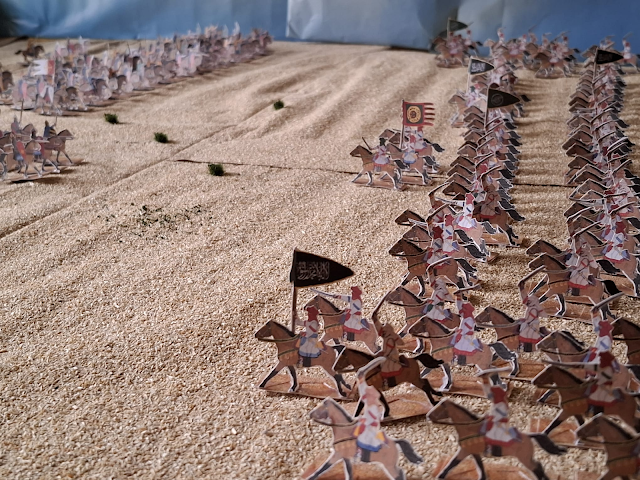I rewieved the uniforms of the Spanish Regiments present at the Battle of Madonna dell'Olmo of my previous post, where I found an error: I considered as present the Irish Regiment Hibernia; actually it was a sort of Iberia, i.e. Espana.
I went to check on the Kronoskaf site for the Spanish troops in SYW and I found out that in the WAS the Irish Regiment Hibernia fought at the defense of Neapoles in 1744 and hence it is impossible its presence the same year at the Battle of Madonna dell'Olmo.
At the contrary, the same source states that the Espana Regiment passed the Alps in 1744. Also my misunderstanig was due to a bad reading of a map of the battle, where the name of the Regiment was faded.
So finally I could draw in their completeness the Spanish Regiments that fought at the Battle of Madonna dell'Olmo.
Note to distiguish the Regiments:Aside the Swiss Jung Reding Regiment, that wore a blue uniform, all the other Spanish Regiment, since 1717 wore white uniforms. To distiguish between them there were different elements: the ribbon of the tricorne and buttons (always of the same colour) were silver of gold. Some units had the trousers of the lining colour, others in white. Other units had the vest in colour, other in white.
I am pretty sure there were difference in the position of the pockets (bewteen totally similar regiments) but at the state I was not able to find any detail (while for Piedmontese units I will have no problem for this).
Also important to point out that some regiment were regular and hence they had a collar of the same lining colours, while others were provincials ("Regimentos Proviciales") and they wore a black tie, with white unifors as per Regulation dating 1734.
In the figure above it is hence possible to distinguish as provincial the Cordoba and Grenada Regiments.
The Regimentos Provincilaes were 17: Jean, Badajoz, Sevilla, Burgos, Lugo, GRANADA, Leon, Oviedo, CORDOBA, Trujillo, Santander, Orense, Santiago, Pontevedra, Tuya and Betanzos.
Some doubts arose about the nuances of the blue for the Toledo Regiment. In fact, from the Spanish sources was "azul" i.e. blue. Then I found this pictures of this regiment
and I tried to reproduce the same "blue" as here:but getting back to Kronoskaf it has the same picture but with a different (and normal) blue
So I kept the former blue colour.Another doubt was the lining fo the Cordoba Regiment. The sources dating after the realm of Felipe V gives red lining while before green. So I kept the green lining. Moreover for the regiment Espana there were sources saying light green (around 1750) while before just bare green. So I did it in a sort of green not too dark, not too light.
There is finally a very interesting adding: while I was preparing my OOB I found that defending the Church of Madonna dell'Olmo there were 3 Battallones Provinciales. I thought they were simply grenadiers taken from regiments present at the battle, (even though the numbers of Provicial Regiments were too low to form 3 battalions) but then I found about this units: it was a special unit of 3 batallions of combined grenadiers taken from militia units; so not belonging to any specific regiment (line or provincial) and hence dressed all the same in a very characteristic purple faced colour.
Grenadero Provincial 1744
This uniform was taken from this (please not the wrong colour for the Rgt Cordoba)Nontheless for the Granaderos Provinciale it is plenty of info and well detailled. This trigged my curiosity also because it gives the correct number of the Battalions but what astonish me is that they were dressed all the same way. I asked some help in The Miniatures Pages and mostly they said that during the Napoleonic period they exsisted, while doubts arose for this period.
Finally I find this in the Book Carlo Emanuele III di Savoia a difesa delle Alpi
nella campagna del 1744, Studio storico militare written by Colonel Carlo Buffa di
Perrero in the year 1887, where he pointed out the existence of 3 Battalions of Provincial Grenadiers, number that perfectly matches with all the numbers I saw, regarding these troops.
This info was taken from a note in the Turin Archive where it was pointed out all the French and Spanish troops that crossed the Alps at the beginning of the 1744 Campaign.
















%202.png)
%201.png)








.png)







.png)



.png)
